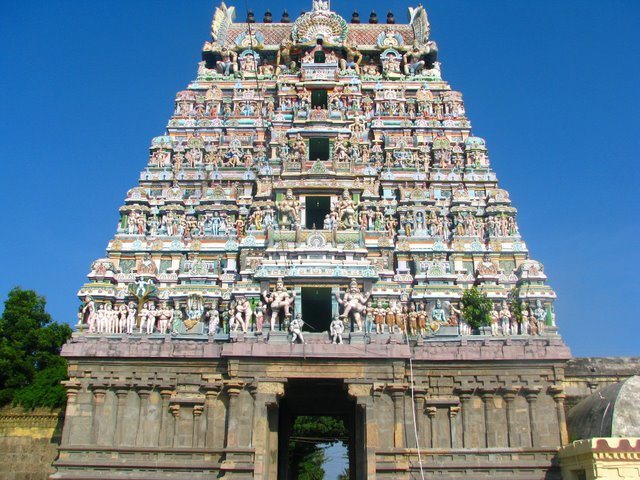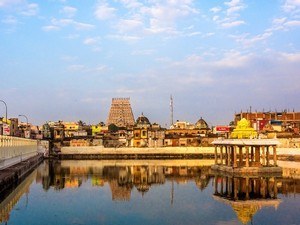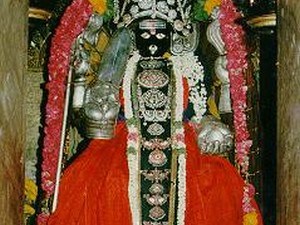Vedaranyam, Thanjavur - Timings, Festivals, History, Darshan, Pooja Timings
Photo Credit: Flickr
 #9 of 31 Places to Visit in Thanjavur
#9 of 31 Places to Visit in Thanjavur
 Distance (From Thanjavur): 106 Kms
Distance (From Thanjavur): 106 Kms
 Trip Duration (Including Travel): 4 Hours/Half Day
Trip Duration (Including Travel): 4 Hours/Half Day
 Place Location: Near Point Calimere In Nagapattinam District
Place Location: Near Point Calimere In Nagapattinam District
 Transportation Options: Bus / Cab
Transportation Options: Bus / Cab
 Travel Tips: This place is usually visited from Nagapattinam (47 Kms)
Travel Tips: This place is usually visited from Nagapattinam (47 Kms)
About Vedaranyam
At a distance of 47 Km from Nagapattinam, and 106 Km from Thanjavur, Vedaranyam is a town in Nagapattinam district in the Indian state of Tamil Nadu. Located near Point Calimere, the town is famous for Vedaranyeswarar Temple dedicated to Shiva, and goddess Vedanayaki. The town is named after the presiding deity of the Vedaranyeswarar Temple. It is one of the famous places to visit as part of the Thanjavur packages. The temple is maintained and administered by the Hindu Religious and Endowment Board of the Government of Tamil Nadu.
History of Vedaranyam
The historical account of Vedaranyam can be traced back to the medieval Chola era in the 9th century. Throughout its history, it has been governed at various times by the Medieval Cholas, Later Cholas, Later Pandyas, the Vijayanagara Empire, and the British. Notably, Paranjothi Munivar, a 13th-century saint, who wrote the book Thiruvilaiyadal Puranam, was born at Vedaranyam. During the struggle for India's independence, C. Rajagopalachari, who would later serve as the first Governor-General of independent India, initiated a salt march in Vedaranyam, which occurred concurrently with Gandhi's Dandi March in 1930, aimed at opposing the salt extraction tax. Until 1991, Vedaranyam was part of Thanjavur District, after which it became incorporated into Nagapattinam District.
Mythology of Vedaranyam
Vedaranyam derives its name from Vedaranyeswarar, the principal deity of the Vedaranyeswarar Temple, a Hindu shrine dedicated to Shiva. The 7th-century Shaiva canonical text Tevaram, authored by Appar and Tirugnanasambandar, references this site as Tirumaraikadu, which translates to the location where the Vedas, the ancient scriptures of Hinduism, originated. According to Hindu tradition, during the great deluge, the Vedas, along with the puranas, agamas, smritis, and sastras, sought refuge beneath this linga and were safeguarded by Lord Shiva. The Vedas revered Shiva at this location, leading to the designation 'Vedaranyam.'
Additionally, another Hindu legend suggests that Rama, the seventh incarnation of Lord Vishnu, is thought to have visited Vedaranyam to seek redemption for the sins incurred during his battle with the demon king Ravana. The footprints of Rama are preserved at a site known as Ramar Padam, located near Vedaranyam.
Things to do in Vedaranyam
Vedaranyeswarar Temple serves as the primary attraction of the town. This sacred site, dedicated to Lord Shiva, is believed to have been constructed in the 9th century under the reign of King Aditya Chola of the Chola dynasty. The temple features a shrine for Thyagaraja, a manifestation of Shiva, and is recognized as one of the seven images of Lord Shiva that King Muchukunda received from Indra. Each of these seven Thyagaraja images is thought to embody distinct dance styles, leading to the classification of these temples as Saptha Vidangam, which translates to temples associated with the seven dance movements. Within this temple, the idol of Lord Shiva is particularly noted for its 'Hamsapthanathaanam,' a dance pose reminiscent of a swan's graceful gait. Additionally, the temple houses shrines dedicated to Goddess Parvati, Ganesha, and Muruga.
The town is also home to the Point Calimere Wildlife Sanctuary, established in 1967. This sanctuary is an ideal destination for nature enthusiasts, offering a diverse array of flora and fauna, including spotted deer, wild boar, semi-wild ponies, and more. Visitors to Vedaranyam can also explore the historical Lighthouse, Ramar Paatham, and Kodikkarai Beach.
Festivals of Vedaranyam
The annual Brahmotsavam in May/June is the prime festival of Vedaranyam Temple and is attended by thousands of devotees from far and near. In addition to this significant event, the temple also observes several other festivals, including Maha Shivaratri in February or March, the ten-day Aadi Pooram festival during July and August, Vinayaka Chaturthi in August or September, and Skanda Sashti in October or November. Notably, Pradosha days, which occur on the 13th day of the New Moon or Full Moon, draw large crowds.
Dress Code & Other Restrictions of Vedaranyam Temple
When planning a visit to the Vedaranyam Temple, it is recommended to adhere to modest dress standards. Men are encouraged to wear a dhoti or pajama paired with an upper garment, as well as formal trousers and shirts. Women may opt for a saree, half saree, or churidhars. It is advisable to refrain from wearing contemporary attire such as mini-skirts, low-waist jeans, shorts, and sleeveless tops while on the temple grounds.
Non-Hindus are welcome to explore the temple complex and appreciate its architectural beauty; however, access to the sanctum sanctorum may be restricted.
Vedaranyam Temple Timings
Monday: 6 AM - 11 AM & 5 PM - 8:30 PM
Tuesday: 6 AM - 11 AM & 5 PM - 8:30 PM
Wednesday: 6 AM - 11 AM & 5 PM - 8:30 PM
Thursday: 6 AM - 11 AM & 5 PM - 8:30 PM
Friday: 6 AM - 11 AM & 5 PM - 8:30 PM
Saturday: 6 AM - 11 AM & 5 PM - 8:30 PM
Vedaranyam Temple Entry Fee
Entry is Free
Best Time to Visit Vedaranyam
The best time to visit Vedaranyam is during the winter months from November to February when the weather is pleasant and ideal for outdoor activities. The summer months can be quite hot and humid, while the monsoon season brings heavy rains that may not be conducive for outdoor activities. Nevertheless, for those interested in experiencing the temple's festivals, it is advisable to visit during the annual Brahmotsavam, as special poojas and rituals are conducted during these times.
How to Reach Vedaranyam
The closest airport is Tiruchirappalli Airport, located around 160 kilometers from the Vedaranyam. About 38 km from Vedaranyam, Velankanni Railway Station is the nearest railhead which has direct trains from Thiruthuraipoondi, Nagapattinam, Thanjavur, Pattukottai, Tiruvarur, and Kumbakonam. Frequent buses connect Vedaranyam to Thanjavur, Velankanni, and Nagapattinam.















